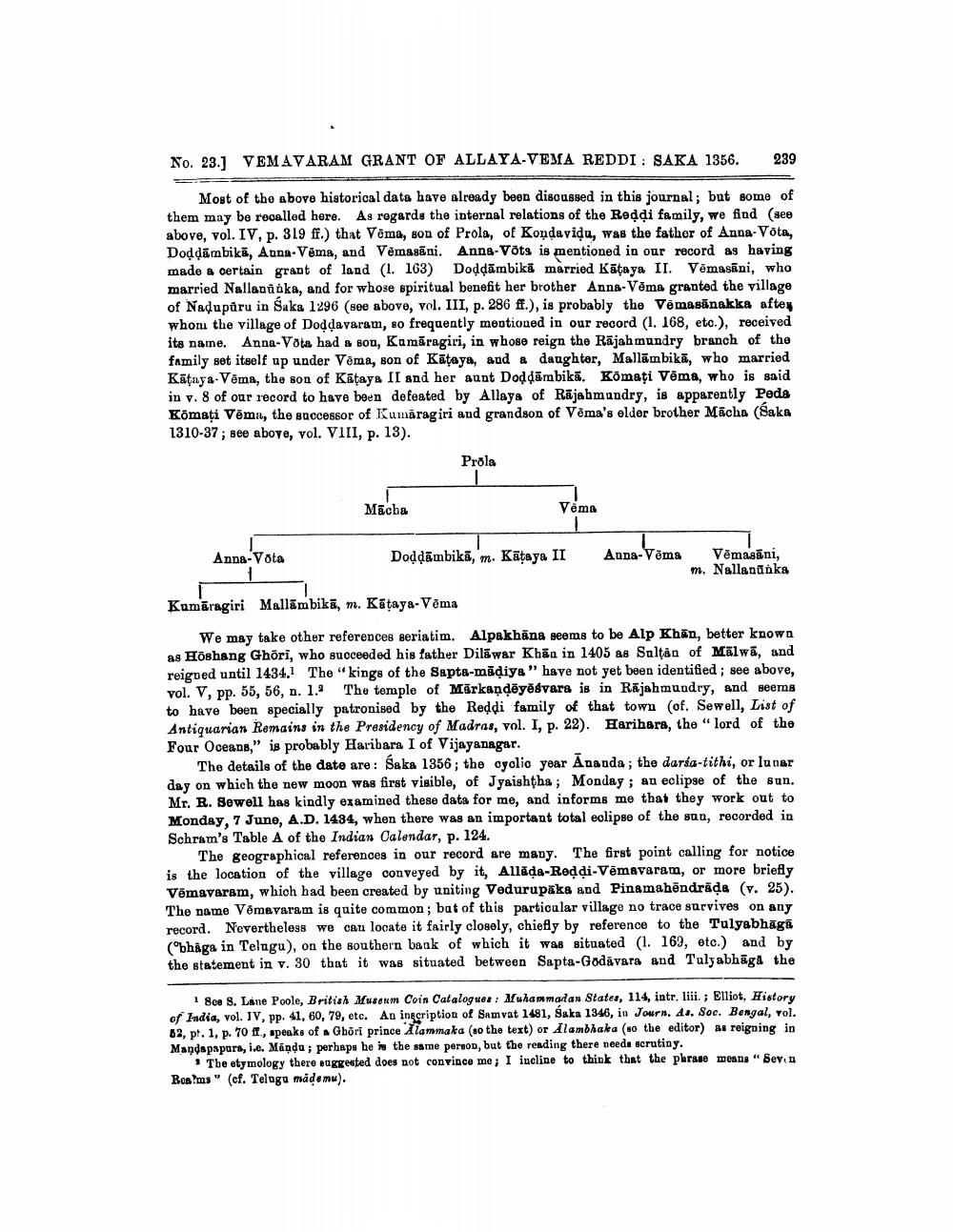________________
No. 23.] VEMAVARAM GRANT OF ALLAYA-VEJA REDDI: SAKA 1356.
239
Most of the above historical data have already been discussed in this journal; but some of them may be recalled here. As rogards the internal relations of the Reddi family, we find (see above, vol. IV, p. 319 ff.) that Vēma, son of Prola, of Kondavidu, was the father of Anna-Vota, Doddambikü, Anna-Vēma, and Vēmasini. Anna-Vots is mentioned in our record as having made a certain grant of land (1. 163) Doddāmbikā married Kataya II. Vēmasāni, who married Nallanióka, and for whose spiritual benefit her brother Anna-Vöms granted the village of Nadupäru in Saka 1296 (see above, vol. III, p. 286 ff.), is probably the Vēmasánakka aftex whon the village of Doddavaram, so frequently mentioned in our record (1. 168, eto.), received its name. Anna-Vota had a son, Kamāragiri, in whose reign the Rājahmundry branch of the family set itself up under Vēma, son of Kātaya, and a daughter, Mallāmbikā, who married Kātaya Vēma, the son of Kātaya II and her aunt Doddāmbikā. Komati Vēma, who is said in v. 8 of our record to have been defeated by Allaya of Rājahmundry, is apparently Peda Komati Vēmi, the successor of Kumāragiri and grandson of Vēma's older brother Mācha (Šaka 1310-37; see above, vol. VIII, p. 13).
Prola
Macha
Vēma
Anna-Vota
Doddāmbikā, 'm. Kātaya II
Auna-Vēms Vēmasāni,
m. Nallanūńka
Kumāragiri Mallām bikā, m. Kātaya-Vēma
We may take other references seriatim. Alpakhana seems to be Alp Khan, better known as Hoshang Ghöri, who succeeded his father Dilāwar Khãn in 1405 as Sultan of Malwā, and reigoed until 1434.1 The "kings of the Sapta-mādiya" have not yet been identified; see above, vol. V, pp. 55, 56, n. 1.9 The temple of Mārkand@yěsvara is in Rajahmundry, and seems to have been specially patronised by the Reddi family of that town (of. Sewell, List of Antiquarian Remains in the Presidency of Madras, vol. I, p. 22). Harihara, the lord of the Four Oceans," is probably Haribara I of Vijayanagar.
The details of the date are: Saka 1356; the cyclio year Ananda; the darsa-tithi, or lunar day on which the new moon was first visible, of Jyaishtha ; Monday; an eclipse of the sun. Mr. R. Sewell has kindly examined these data for me, and informs me that they work out to Monday, 7 June, A.D. 1484, when there was an important total eclipse of the sun, recorded in Schram's Table A of the Indian Calendar, p. 124.
The geographical references in our record are many. The first point calling for notice is the location of the village conveyed by it, Allada-Reddi-Vēmavaram, or more briefly Vēmavaram, which had been created by uniting Vedurupaka and Pinamahēndrada (v. 25). The name Vömavaram is quite common; bat of this particular village no trace survives on any record. Nevertheless we can locate it fairly closely, chiefly by reference to the Tulyabhāga (bhåga in Telugu), on the southern baak of which it was situated (1. 169, etc.) and by the statement in v. 30 that it was situated between Sapta-Godavara and Tulyabhāgå the
18ce S. Lane Poole, British Museum Coin Catalogues: Muhammadan States, 114, intr. liii.; Elliot, History of India, vol. IV, pp. 41, 60, 79, etc. An inscription of Samvat 1481, Saka 1346, in Journ. As. Soc. Bengal, vol. 82, pt. 1, p. 701, speaks of Ghöri prince Alammaka (so the text) or Alambhaka (so the editor) as reigning in Mandapapora, i.e. Manda; perhaps he is the same person, but the reading there needs scrutiny.
• The etymology there suggested does not convince me; I iucline to think that the plarase means "Sevin Bos!ms" (cf. Telaga mademu).




